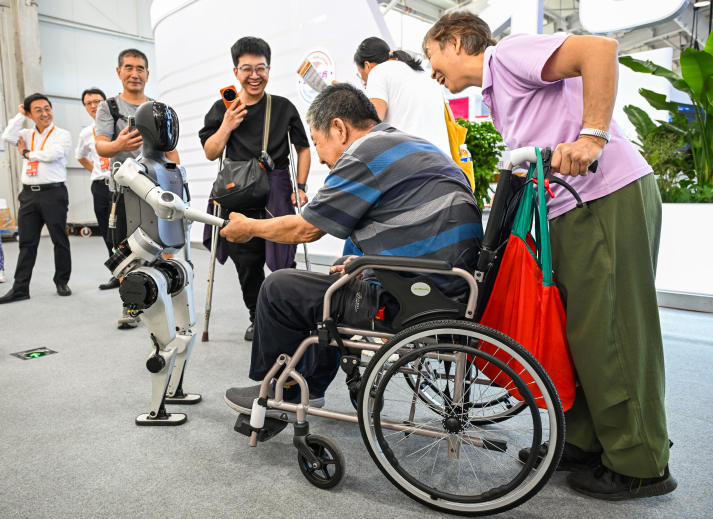| China |
| Fair highlights how technology is reshaping global trade in services | |
|
|
 Labubu dolls on display at the booth of Chinese toy producer Pop Mart at the China International Fair for Trade in Services (CIFTIS) in Beijing on September 13 (WEI YAO)
On September 10, David Ingram, a tourist from Australia, purchased a souvenir at the China International Fair for Trade in Services (CIFTIS) in Beijing and received an instant refund of the value-added tax in yuan. During this year's CIFTIS, which took place in the Chinese capital on September 10-14, multiple merchants offered "buy-and-refund" services for tax-free goods. "I really like Chinese cultural and creative products but, in the past, I could only process tax refunds at the airport, which was quite inconvenient," Ingram said. "Now, I can complete the refund before going to the airport, which feels very convenient and greatly enhances my travel experience in China." Additionally, international visitors have found it is easier to travel to and in China. During border inspection, travelers can achieve swift clearance via facial recognition and passport verification. After entry, they can apply for a super SIM card that integrates functions including calls, Internet access, subway rides and electronic payments, aiming to fully address the travel and payment needs of inbound tourists. The card can be easily obtained at designated outlets of China Unicom, a major state-owned telecommunications operator, at the airport or in the city. These services are just a glimpse of the diverse offerings of this year's CIFTIS. As a service trade fair rooted in Beijing, the event has been held annually since its inception in 2012. "It has now grown into the world's largest comprehensive trade in services fair, strongly testifying to the opening up, innovation and vigorous development of China's service industry and trade," said Vice Minister of Commerce Sheng Qiuping. Tech turnaround The 2025 CIFTIS was held at Beijing's Shougang Park. The site had been home to a major steel mill before its relocation out of Beijing ahead of the Beijing 2008 Summer Olympics. Some facilities were later renovated and served as venues for several events of the Beijing 2022 Winter Olympics. Themed Embracing Intelligent Technology, Empowering Trade in Services, the service trade fair attracted nearly 2,000 onsite exhibitors from 85 countries and international organizations. Australia, this year's guest country of honor, brought nearly 60 institutions and enterprises to the fair, with an exhibition area of 360 square meters—the largest ever for a CIFITS guest country of honor. The event featured 14 exhibition halls, nine thematic exhibitions and multiple forums and supporting events. One highlight was the empowerment of the service sector through technology, as the rapid development of cutting-edge technologies such as AI and humanoid robots has injected new vitality into the service industry and became a major attraction for visitors. Robotics technology drew considerable attention at the exhibition, where humanoid robots demonstrated both advanced skills and practical applications. "Since mass production began in June, our company has produced over 300 humanoid robots within three months," Han Shenren, chief financial officer of Songyan Power (Beijing) Technology Co. Ltd., a Beijing-based company, told Xinhua News Agency. "Current orders are mainly for scientific research and education, exhibitions and cultural tourism guides, with orders for scientific research and education accounting for over 50 percent. Demand in cultural tourism and exhibition display is continuously growing." In terms of application scenarios, several domestic humanoid robots have been trained in environments such as logistics enterprises and automotive production lines. Some are already being piloted in industrial manufacturing, retail delivery and food and beverage services, indicating a clear acceleration in commercial adoption. Ke Zhendong, Vice President of Leju Robot (Shenzhen) Co. Ltd., pointed out that, compared to traditional industrial robots, humanoid robots offer greater versatility, making them more adaptable to the rapidly evolving demands of industries such as automotive and electronics. They can flexibly handle complex production environments involving multiple items and processes. "The market potential for humanoid robots is enormous," he added. More than 100 companies launched over 190 new products and other achievements during this year's event, including the world's first 3D-printed polymer, fatigue-resistant, absorbable vascular stent and China's first professional photonic quantum computer surpassing the 1,000-qubit scale, demonstrating the transition from smaller, experimental devices to larger, more powerful systems. In the healthcare section, a thematic exhibition featured a wide array of technologically advanced and commercially important products, many of which made their global or Chinese debut. For instance, Tongren Ophthalmology introduced AI-powered glasses capable of conducting a full-body health assessment through a single retinal scan, instantly generating detailed reports. Siemens Healthineers, together with Varian Medical Systems—a Fortune 500 company—unveiled the world's first photon-counting CT scanner, which provides exceptionally precise, hair-thin vascular imaging, thereby reducing the need for invasive diagnostic procedures.  A senior visitor shakes hands with a humanoid robot at the CIFTIS in Beijing on September 13 (WEI YAO)
The cultural cadence In the cultural and tourism services section, immersive experiences and culturally inspired creative products have over the years become standard attractions. At Beijing Municipal Cultural Heritage Bureau's booth, an AI-generated digital assistant designed to help visitors quickly generate personalized itineraries attracted much media attention. "The AI tour guide project was launched last year and has become fully operational as of this year," a staff member told newspaper Beijing Daily. "Users can customize the avatar's appearance, choose between the adult or child versions, and select their language and converse with it. Based on your availability—whether it's 30 minutes, one hours or two hours—it designs tailored exhibition routes and exploration plans." This digital guide service has been rolled out nationwide. Alongside these tech-driven services, Chinese toy manufacturers showcased some of their most sought-after collections as well as new releases during the CIFTIS. Leading blind box brand Letsvan made its debut at the event with popular intellectual properties (IPs), including panda plush sensation Wakuku, as well as the emotionally resonant Siinono. Meanwhile, Pop Mart, a major player in the toy-producing scene, drew large crowds with a dessert stall selling biscuits shaped like its beloved characters Labubu and Dimoo. Museum-inspired creative products have also become a hallmark of cultural consumption. A recent example is the magnet replica of the Phoenix Crown from the National Museum of China, modeled after historical artifacts. "The CIFTIS is incredibly expansive—here you can see both cutting-edge technological products and cultural items rich in traditional Chinese elements," a visitor said. "I hope to see more products and services in the future that blend these two aspects." BR (Print Edition Title: Service Trade, Transformed) Copyedited by Elsbeth van Paridon Comments to yuanyuan@cicgamericas.com |
|
||||||||||||||||||||||||||||||
|